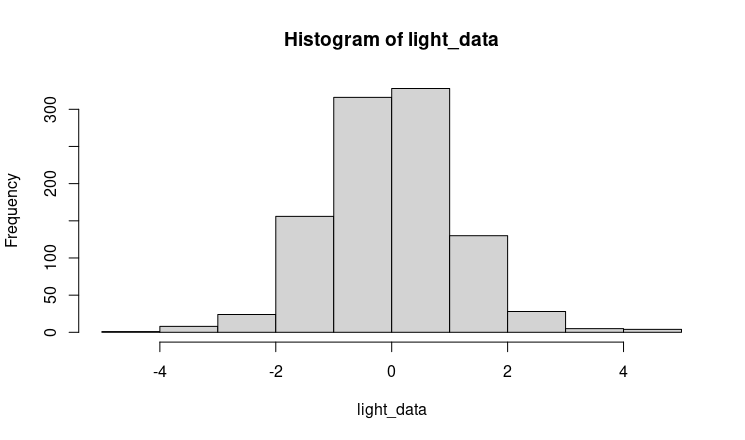Cauchy. The reason for the the strange histogram from Cauchy data is precisely because
you are getting many extreme values in the tails--too sparse and too extreme to show
well on your histogram. A data summary or boxplot might be more useful to visualize
what's going on.
set.seed(999)
x = rcauchy(10000)
summary(x)
Min. 1st Qu. Median Mean 3rd Qu. Max.
-5649.323 -0.970 0.021 -0.037 1.005 2944.847
x.trnk = x[abs(x) < 200] # omit a few extreme values for hist
length(x.trnk)
[1] 9971
par(mfrow=c(2,1))
dcauchy(0)
[1] 0.3183099 # Height needed for density plot in histogram
hist(x.trnk, prob=T, br=100, ylim=c(0,.32), col="skyblue2")
curve(dcauchy(x), add=T, col="red", n=10001)
boxplot(x.trnk, horizontal=T, col="skyblue2", pch=20)
par(mfrow=c(1,1))

The standard Cauchy distribution (no parameters specified) is the same as Student's t
distribution with DF = 1. The density function integrates to $1,$ as appropriate, but
its tails are so heavy that the integral for its 'mean' diverges, so its mean doesn't
exist. One speaks of its median as the center of the distribution.
Student's t, DF = 10. There is nothing particularly unusual about Student's t distribution with DF = 10.
Its tails are somewhat heavier than for standard normal, but not so much heavier
that it's hard to make a useful histogram (no truncation needed). And its mean is $\mu=0.$
y = rt(10000, 10)
summary(y)
Min. 1st Qu. Median Mean 3rd Qu. Max.
-5.988219 -0.698855 -0.006711 -0.005902 0.685740 6.481538
dt(0,10)
[1] 0.3891084
par(mfrow=c(2,1))
hist(y, prob=T, br=30, ylim=c(0,.4), col="skyblue2")
curve(dt(x,10), add=T, col="red", n=10001)
boxplot(y, horizontal=T, col="skyblue2", pch=20)
par(mfrow=c(1,1))

The distribution $\mathsf{T}(10)$ is sufficiently heavy-tailed that
samples from it as large as $n=10\,000$ tend to show many boxplot outliers---as seen above. In a simulation of $100\,000$ samples of size $10\,000,$
almost every sample showed at least one outlier and the average number
of outliers per sample was more than 180. [This simulation runs slowly
because each sample of $10,000$ needs to be sorted in order to determine
its outliers.]
set.seed(2020)
nr.out = replicate(10^5, length(boxplot.stats(rt(10000,10))$out))
mean(nr.out)
[1] 188.5043
mean(nr.out>0)
[1] 1




